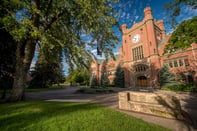Published on
Who Is The For-Profit Student?

As the economy struggles to free itself from the grip of what feels like an eternal recession, and unemployment rates across most regions and industries remain discouragingly high, record numbers of people are returning to school, hoping that higher education will bring a higher salary, or even just a steady salary. As a result, for-profit schools have sprung up and flourished, promising to equip and train students for new careers in half the time required by most mainstream, non-profit institutions.
For-profit schools that can accept Federal student aid offer unprecedented accessibility to a student demographic that often finds itself shut out from more traditional non-profit schools and community colleges; these students are generally considered to be “high-risk,” for several reasons: they never attended college or did not successfully complete a degree program, they did poorly in high school or never graduated, they have been out of school for many years, and/or they are impoverished. The success of for-profit institutions in recruiting these students has unfortunately led to one of the most pervasive myths about the for-profit industry, which is that they routinely use dishonest or predatory tactics to convince high-risk students to start degree programs, in order to profit from these students’ loans and aid. While this has unfortunately occurred at a few unscrupulous institutions, it is by no means the norm for the for-profit industry. Further, it has marred the reputation of the entire for-profit industry, and has left many wondering if the for-profit system really benefits its students, or if it simply leaves them with a mountain of debt they cannot repay and little to show for it. To answer this question of validity and efficacy, we must not look only at government regulations, policies and practices of for-profit conglomerates, or “gainful employment” statistics, we must also look at the actual students of for-profit schools: who they are, where they come from, and where they end up, in order to obtain a true sense of the costs and benefits of earning a degree from a for-profit institution.
The for-profit system does work for students with the drive and resilience and patience it takes to graduate, and there are for-profit institutions that make every effort to do right by their students in every way possible by establishing in-house systems of support and assistance through departments designed to mentor, tutor and counsel: Student Services is one of these, and is rapidly developing and expanding at many for-profit schools. The employees at these institutions are honest and forthcoming about the realities and challenges of life for a new, non-traditional student, and most are just as passionate about saying “no” to an applicant as they are about saying “yes.” Furthermore, students are thoroughly counseled regarding their student loans, expectations of repayment of those loans, and many institutions highly recommend the student only take the amount of loan money necessary to cover the cost of tuition and books. In addition, many for-profit schools also offer extensive pre-career training in skills like resume writing, interview skills and body language, and professional demeanor and attire. These schools and their constituent students are changing the face of for-profit education, and will be the cornerstone of the future for the industry.
So who are for-profit students, exactly? Demographic information suggests that they are of all ages, races, and backgrounds, but that most are displaced or disenfranchised in some way. They are single mothers and fathers, they are non-native English speakers, and they are racial or ethnic minorities. They are women escaping domestic violence and attempting to create a new future for themselves and their families. They are veterans returning from service to find that their day jobs have disappeared. They are factory workers who lost jobs during the recession, or administrative professionals who are told after twenty years of service that they must obtain a degree in order to continue their employment. They are your neighbor, your waitress, or the person in the car next to you at the stoplight. They are the working poor, and many are burning the candle at both ends just to make it to the next paycheck, support payment, or food voucher. Coming back to school is a monumental sacrifice for most of them in terms of time, money, and energy, and they frequently come to school with a host of additional challenges and obstacles that can (and sometimes do) prevent them from being successful there. But while it is true that a large percentage of for-profit students are high-risk, and they are more likely to withdraw from school or default on their loans because of precarious financial or personal situations, this should not mean that they do not deserve or should not be given the opportunity to better themselves through education and to break the cycle of generational poverty in which many of them feel trapped.
Many for-profit students are students who have been unsuccessful in previous attempts to earn a college degree. Many attended college immediately after high school and performed poorly due to immaturity, inability to meet academic requirements, or simply not taking their education seriously at that time. Others are not able to meet the stricter admissions requirements of non-profit schools and may have never taken any of the standardized tests, such as the SAT or ACT, that are typically required for admission to degree programs at non-profit schools. Still others have been out of school for ten years or more, and as such have lost much of the knowledge and skill they acquired there. But these students are now actively seeking the intensive learning environment of higher education, desiring to better their lives through a college degree and the skills and opportunities it provides. And because such a large portion are low-income or are already living in abject poverty, they are also drawn to the speed, convenience, and flexibility of the programs offered by for-profits so that they may continue to work while in school, and can return to the workforce full-time as soon as possible. For-profit schools provide an education to students who have been heretofore kept from realizing their dreams, often deemed incapable of learning at a higher level. For-profits have proven these assumptions to be largely untrue by recognizing that these displaced and disenfranchised students simply have different needs than more traditional college students in order to be successful in a post-secondary learning environment. And because their needs and challenges are so different, attempts to compare for-profit students to more traditional student populations, or to measure the success of either population in comparison to the other, are, at best, misguided.
But recognizing this diversity of need also means accounting for it and addressing it in all aspects of the educational experience. For-profits must account for the fact that students living in poverty are generally also living in a completely different culture than the middle class culture in which most educational institutions and employers operate. Though incoming students have varying degrees of exposure to and understanding of the cultural rules and expectations of the middle class, by and large that knowledge exists on a subconscious level and is not readily accessible (at least not immediately) in everyday interactions with classmates and staff. These differences in culture can create stress and frustration, or even outright conflict for all parties involved. They are fairly comprehensive, and often dictate students’ language and word choice, priorities, decision-making, and philosophies on money, possessions, social emphasis, destiny, and, of course, education. It is the ability to reconcile and master these cultural differences, and to become adept at knowing when and where each culture’s rules apply that is frequently what “makes” or “breaks” a for-profit student’s likelihood of success both in the classroom and after graduation. Therefore, it is (or should be) the responsibility of the for-profit school to provide not only the necessary knowledge and skills to qualify its students for a degree or a career, but also the necessary knowledge and skills to qualify them to participate in the culture of the workplaces or advanced degree programs to which we hope they will proceed.
In essence, the for-profit student is every man and every woman desiring to make a positive change in his or her life– no different from a traditional college student in this regard. Do some enroll at for-profits for the wrong reasons? Yes. But the same can be said of those attending non-profits. Most for-profit students just want to better themselves, become more successful, and show their children that they can overcome any circumstance or adversity if they work hard, set goals, persevere, and earn a degree, and most for-profit schools simply want to help them get there.
Author Perspective: Administrator



